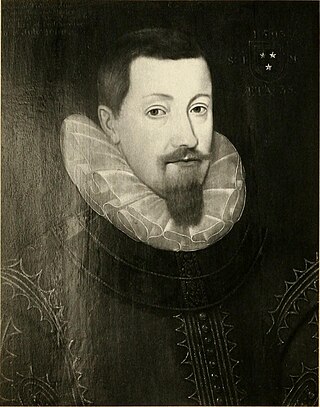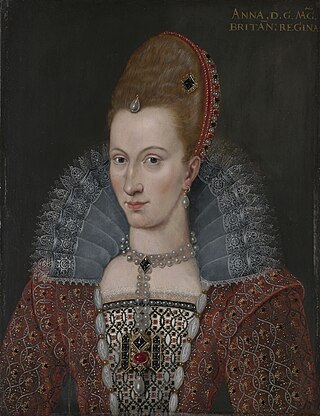Related Research Articles

The ruins of Linlithgow Palace are located in the town of Linlithgow, West Lothian, Scotland, 15 miles (24 km) west of Edinburgh. The palace was one of the principal residences of the monarchs of Scotland in the 15th and 16th centuries. Although maintained after Scotland's monarchs left for England in 1603, the palace was little used, and was burned out in 1746. It is now a visitor attraction in the care of Historic Environment Scotland.

John Maitland, 1st Lord Maitland of Thirlestane, of Lethington, Knight (1581), was Lord Chancellor of Scotland.
William Schaw was Master of Works to James VI of Scotland for building castles and palaces, and is claimed to have been an important figure in the development of Freemasonry in Scotland.

Andrew Mansioun, or Mentioun or Manschone or Manson, was a French artist who worked at the court of James V, King of Scots. He was the master carpenter of the Scottish artillery for Mary, Queen of Scots and James VI of Scotland.
Jean Fleming, Countess of Cassilis (1553/4–1609) was a Scottish noblewoman and courtier at the court of James VI of Scotland, and a survivor of domestic violence.
Thomas Foulis was a Scottish goldsmith, mine entrepreneur, and royal financier.

John Murray, 1st Earl of Tullibardine was a Scottish courtier and leader of the Clan Murray.

On 17 May 1590, Anne of Denmark was crowned Queen of Scotland. There was also a ceremony of joyous entry into Edinburgh on 19 May, an opportunity for spectacle and theatre and allegorical tableaux promoting civic and national identities, similar in many respects to those performed in many other European towns. Celebrations for the arrival of Anne of Denmark in Scotland had been planned and prepared for September 1589, when it was expected she would sail from Denmark with the admirals Peder Munk and Henrik Gyldenstierne. She was delayed by accidents and poor weather and James VI of Scotland joined her in Norway in November. They returned to Scotland in May 1590.
Sir James Sandilands was a courtier to King James VI and I and captain of Blackness Castle
Alexander Barclay was an apothecary in Edinburgh.

Jacques de Bousie was a Flemish confectioner known as a "sugarman" working in Edinburgh, Scotland, employed by James VI and Anne of Denmark.

Queen Elizabeth I of England paid a subsidy to King James VI of Scotland from 1586 to 1602. This enabled her to influence James by delaying or deferring payments to his diplomats in London. Records survive of the yearly amounts, and details of the expenditure in some years. A large proportion of the money was spent on the royal wardrobe of James and Anne of Denmark. Some royal expenses were met by Anne of Denmark's dowry, which was known as the "tocher". The regular incomes of the Scottish crown were feudal rents, customs, and "compositions" charged on grants of land. Accounts for royal incomes and payments survive as the exchequer rolls and lord treasurer's accounts and have been published as historical sources.
Robert Abercromby or Abircrumby was a Scottish leatherworker serving the Scottish monarchy in the 16th century.
Jerome Bowie was a servant of James VI of Scotland as a sommelier and Master of the Wine Cellar, in charge of the purchase and serving of wine.
Alexander Durham was a Scottish courtier and administrator.

William Stewart of Grandtully (1567–1646) was a Scottish landowner and courtier.

Records survive of the expenses made to feed the Scottish royal household in the sixteenth century, and the remains of royal kitchens can be seen in the ruins of palaces and castles. Archaeologists can recover evidence of diet from deposits including waste from meals and food preparation.
John Clavie or Clavee was a Scottish apothecary who worked for James VI and I and the royal family.
Hans Poppilman was a Danish cook who served Anne of Denmark in Scotland and England.

Elizabeth Sinclair was a servant of Margaret Tudor (1489-1541), the wife of James IV of Scotland.
References
- ↑ Charles Thorpe McInnes, Accounts of the Treasurer, vol. 13 (Edinburgh, 1978), p. 284.
- ↑ David Masson, Register of the Privy Council of Scotland, vol. 3 (Edinburgh, 1880), pp. 452-3.
- ↑ Miles Kerr-Peterson & Michael Pearce, 'James VI's English Subsidy and Danish Dowry Accounts, 1588–1596', Scottish History Society Miscellany XVI (Woodbridge, 2020), p. 75.
- ↑ Michelle Beer, Queenship at the Renaissance Courts of Britain (Woodbridge, 2018), p. 78: James Balfour Paul, Accounts of the Lord High Treasurer of Scotland, vol. 2 (Edinburgh, 1900), pp. lxxii, lxxviii, 386: Sarah Carpenter, '"To thexaltacyon of noblesse": A Herald’s Account of the Marriage of Margaret Tudor to James IV', Medieval English Theatre, 29 (2007): Thomas Hearne, Collectanea de Rebus Anglicanis, vol. 4 (London, 1809), p. 298.
- ↑ George Powell McNeill, Exchequer Rolls of Scotland, 1589-1594, vol. 22 (Edinburgh, 1903), p. 33.